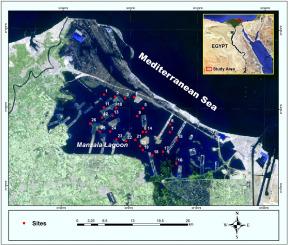介形类在埃及东北部Manzala泻湖的环境指示作用
IF 2.2
4区 地球科学
Q2 GEOSCIENCES, MULTIDISCIPLINARY
引用次数: 0
摘要
介形类已被用作水生生态系统质量的生物指标。不幸的是,对埃及北部沿海泻湖的介形类进行的研究数量有限。因此,本研究是对埃及Manzala泻湖底部沉积物中最近的介形类组合进行研究的一种尝试。检测它们对环境参数的反应是另一个目标。所研究的群落由一个相对多样化的组合组成,其中鉴定了16属19种。由于泻湖中普遍存在半咸淡水环境,所有地点都有最常见的半咸淡水物种居住,其相对丰度在96.2至100%之间。此外,本研究还记录了在部分地点少量发生的Loxoconcha elliptica Brady、Leptocythere castanea (Sars)和cydopsis vidua (m本文章由计算机程序翻译,如有差异,请以英文原文为准。

Ostracods as environmental indicators in Manzala Lagoon (NE Egypt)
Ostracods have been used as bio-indicators for the quality of aquatic ecosystems. Unfortunately, limited number of studies have been done on the ostracods from the northern coastal lagoons of Egypt. Therefore, the present work is an attempt to examine the Recent ostracod assemblages from the bottom sediments of Manzala Lagoon, Egypt. The detection of their response to the environmental parameters is another target. The studied community consists of a relatively diverse assemblage, where 19 species belonging to 16 genera are identified. Due to the prevalence of brackish conditions in the lagoon, all sites are inhabited by the most common brackish species, Cyprideis torosa (Jones), where its relative abundance ranges between 96.2 and 100 %. Also, the current study records minor occurrence of Loxoconcha elliptica Brady, Leptocythere castanea (Sars) and Cypridopsis vidua (Müller) in some sites. Moreover, the presence of allochthonous marine assemblage is limited to the area near the connection to the Mediterranean sea. In addition, ostracods show different responses to the type of bottom sediments, where Cyprideis torosa can inhabit both muddy and sandy substrates, whereas Cypridopsis vidua is restricted only to the muddy substrate. Furthermore, the occurrence of marine assemblage is restricted to sandy substrate near the inlet of seawater. The response of ostracods to heavy metal pollution is also documented. However, the studied sites are heavily polluted with Cd, only some individuals of C. torosa are still alive, reflecting its toeleranc to pollution. Furthermore, the variations in the values of pH have no observed effects on the structure of the examined ostracods, as they completely lie in the alkaline side. Also, there is no remarkable relationship between the depth and the patterns of distribution of ostracods. Consequently, salinity, substrate sediment types and the levels of pollution are the most important factors controlling the distribution of ostracods in the studied lagoon. Geographically, the identified ostracods show a great similarity to those observed in other Mediterranean lagoons.
求助全文
通过发布文献求助,成功后即可免费获取论文全文。
去求助
来源期刊

Journal of African Earth Sciences
地学-地球科学综合
CiteScore
4.70
自引率
4.30%
发文量
240
审稿时长
12 months
期刊介绍:
The Journal of African Earth Sciences sees itself as the prime geological journal for all aspects of the Earth Sciences about the African plate. Papers dealing with peripheral areas are welcome if they demonstrate a tight link with Africa.
The Journal publishes high quality, peer-reviewed scientific papers. It is devoted primarily to research papers but short communications relating to new developments of broad interest, reviews and book reviews will also be considered. Papers must have international appeal and should present work of more regional than local significance and dealing with well identified and justified scientific questions. Specialised technical papers, analytical or exploration reports must be avoided. Papers on applied geology should preferably be linked to such core disciplines and must be addressed to a more general geoscientific audience.
 求助内容:
求助内容: 应助结果提醒方式:
应助结果提醒方式:


